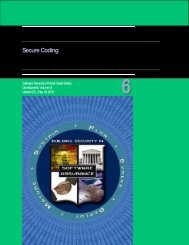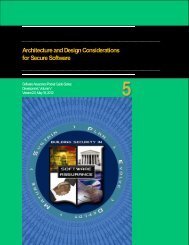04 Shakeel Tufail OpenSAMM ... - Build Security In
04 Shakeel Tufail OpenSAMM ... - Build Security In
04 Shakeel Tufail OpenSAMM ... - Build Security In
- No tags were found...
Create successful ePaper yourself
Turn your PDF publications into a flip-book with our unique Google optimized e-Paper software.
Review of existing secure SDLC
CLASP• Comprehensive, Lightweight Application <strong>Security</strong>Process• Centered around 7 AppSec Best Practices• Cover the entire software lifecycle (not justdevelopment)• Adaptable to any development process• Defines roles across the SDLC• 24 role-based process components• Start small and dial-in to your needs
Microsoft SDL• Built internally for MS software• Extended and made public for others• MS-only versions since public release
Touchpoints• Gary McGraw’s and Cigital’s model
Lessons Learned• Microsoft SDL• Heavyweight, good for large ISVs• Touchpoints• High-level, not enough details to executeagainst• CLASP• Large collection of activities, but no priorityordering• ALL: Good for experts to use as a guide, but hardfor non-security folks to use off the shelf
Drivers for a Maturity Model• An organization’s behavior changes slowly over time• Changes must be iterative while working toward longtermgoals• There is no single recipe that works for all organizations• A solution must enable risk-based choices tailor tothe organization• Guidance related to security activities must beprescriptive• A solution must provide enough details for nonsecurity-people• Overall, must be simple, well-defined, and measurable
Therefore, a viable modelmust...• Define building blocks for an assuranceprogram• Delineate all functions within an organizationthat could be improved over time• Define how building blocks should be combined• Make creating change in iterations a nobrainer• Define details for each building block clearly• Clarify the security-relevant parts in a widelyapplicable way (for any org doing software
Understanding the model
SAMM <strong>Security</strong> Practices• From each of the Business Functions, 3 <strong>Security</strong>Practices are defined• The <strong>Security</strong> Practices cover all areas relevant tosoftware security assurance• Each one is a ‘silo’ for improvement
Under each <strong>Security</strong>Practice• Three successive Objectives under each Practice definehow it can be improved over time• This establishes a notion of a Level at which anorganization fulfills a given Practice• The three Levels for a Practice generally correspond to:• (0: Implicit starting point with the Practice unfulfilled)• 1: <strong>In</strong>itial understanding and ad hoc provision of thePractice• 2: <strong>In</strong>crease efficiency and/or effectiveness of the Practice• 3: Comprehensive mastery of the Practice at scale
Check out this one...
Per Level, SAMMdefines...• Objective• Activities• Results• Success Metrics• Costs• Personnel
Approach to iterativeimprovement• Since the twelve Practices are each a maturity area,the successive Objectives represent the “buildingblocks” for any assurance program• Simply put, improve an assurance program inphases by:1. Select security Practices to improve in next phaseof assurance program2. Achieve the next Objective in each Practice byperforming the corresponding Activities at thespecified Success Metrics
Applying the model
Conducting assessments• SAMM includes assessmentworksheets for each <strong>Security</strong> Practice
Assessment process• Supports both lightweight and detailedassessments• Organizations may fall in betweenlevels (+)
Creating Scorecards• Gap analysis• Capturing scores from detailedassessments versus expectedperformance levels• Demonstrating improvement• Capturing scores from before andafter an iteration of assuranceprogram build-out• Ongoing measurement• Capturing scores over consistent timeframes for an assurance program thatis already in place
Roadmap templates• To make the “building blocks” usable,SAMM defines Roadmaps templates fortypical kinds of organizations• <strong>In</strong>dependent Software Vendors• Online Service Providers• Financial Services Organizations• Government Organizations• Organization types chosen because• They represent common use-cases• Each organization has variations intypical software-induced risk• Optimal creation of an assurance
<strong>Build</strong>ing AssurancePrograms
Case Studies• A full walkthrough with proseexplanations of decision-making as anorganization improves• Each Phase described in detail• Organizational constraints• <strong>Build</strong>/buy choices• One case study exists today, severalmore in progress using industry partners
The SAMM 1.0 release
SAMM and the real world
Expert contributions• Built based on collected experiences with100’s of organizations• <strong>In</strong>cluding security experts, developers,architects, development managers, ITmanagers
<strong>In</strong>dustry support• Several more case studies underway
The <strong>OpenSAMM</strong> Project• http://www.opensamm.org• Beta released August 2008, 1.0 released March2009• Dedicated to improving the SAMM frameworkand related resources• Always vendor-neutral, but lots of industryparticipation• Open and community driven• Targeting new releases every ~18-24 months• Change management process
Future plans• Mappings to existing standards andregulations (many underway currently)• PCI, COBIT, ISO-17799/27002, ISM3,etc.• Additional roadmaps where need isidentified• Additional case studies• Feedback for refinement of the model• Translations into other languages
What to do next• Download the <strong>OpenSAMM</strong> 1.0 PDFfrom http://www.opensamm.org (1 min)• Read the Executive Summary (5 min)• Do the Assessment Worksheets (20min)• Discuss your organization’s results withstakeholders (30 min)
Thanks for your time! Questions?http://www.opensamm.orgPravir Chandra<strong>OpenSAMM</strong> Project Leadchandra@owasp.org
Other “modern”approachs• Microsoft SDL Optimization Model• Fortify/Cigital <strong>Build</strong>ing <strong>Security</strong> <strong>In</strong>Maturity Model (BSIMM)
SDL Optimization Model• Built by MS to make SDL adoptioneasier
BSIMM• Framework derived from SAMM Beta• Based on collected data from 9 largefirms
BSIMM vs.<strong>OpenSAMM</strong>• Top-down (BSIMM) vs. bottom-up (SAMM)• Observations from unproven systems out of steadystate• Faith-based cargo cults being directed by experts• Ask yourself...• Are you trying to measure yourself against the bigdogs?• Are you just trying to get a program started?• Do observed activities show you the right stepping
















